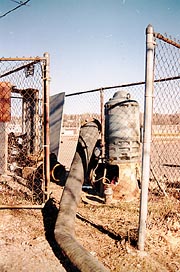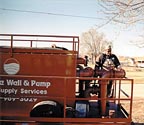
The first of four wells rehabbed on this project in central Illinois.

The entire project was completed in the scheduled two weeks.

General field superintendent Joe Foppe keeps the treatment process moving along smoothly.

Brotcke uses specially designed equipment as part of its high velocity injection system.

Superintendent Jeremy Bock fires up the Chevrolet 454 V-8 engine.

Shop superintendent Bryan Bingel seen during one of his last days in the old machine shop; he’s now set up in Brotcke’s brand new 1,000-square-foot shop.

The back yard of Brotcke Well & Pump’s headquarters.

Paul Brotcke (r), with vice president Tim Kelly.
Looking a ways down the road, Brotcke says, “I think our future expansion plans would include a deep-hole direct-rotary drill rig, but that’s on the back burner for right now.” Having observed the Brotcke operation, it’s safe to say when that eventually does happen, it will be done with flawless execution.
Report Abusive Comment